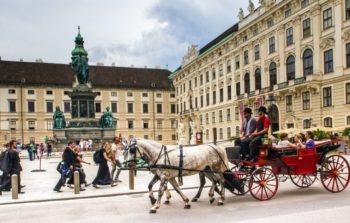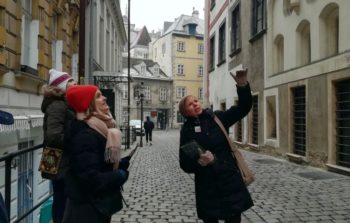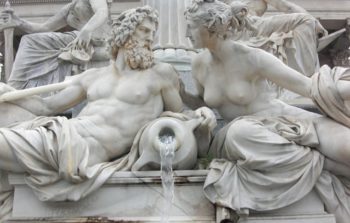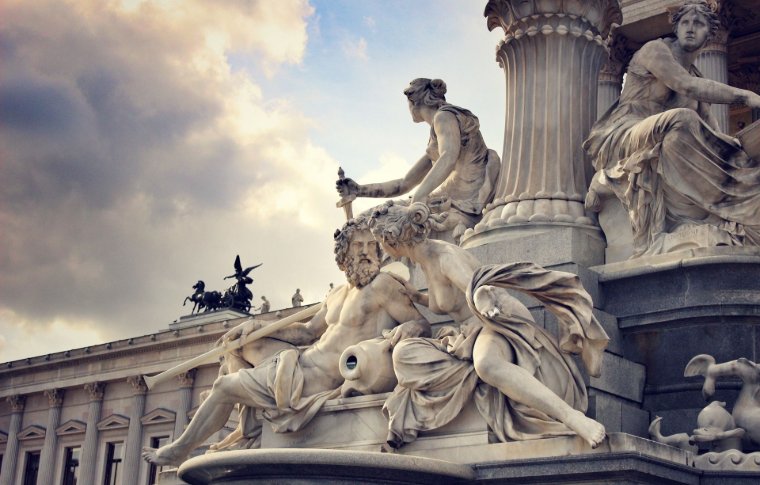Our tour guide – Annelie—was truly superb! Our tour was centered on the music history of the area, and she surprised me with her in-depth knowledge of the history. As a professional musician, I was especially pleased with the insight and background she provided. I would heartily recommend her for anyone seeking a unique and enriching overview of the areas history.
An Introduction to Vienna
3-Hour Tour
Get a Solid Feel for the Imperial City
Hofburg, Stephansdom, Ringstrasse, Naschtmarkt, MuseumsQuartier
Led by an expert local historian, you’ll gain a rich overview of the Innere Stadt’s major sites and enjoy immersion into Viennese culture – from waltzes and pastries to world-class museums and classical music. Along the way, you’ll gain a solid feel for Vienna’s past and present – from its centuries as the Austro-Hungarian Empire’s ruling city through the dark chapters of Anschluss and WWII – concluding with the social and political makeup of Vienna today.
Highlights
Explore the clash between tradition and innovation at the Baroque Hofburg and the modernist Loos House.
Stroll through narrow streets reminiscent of Old Vienna, passing places known by Mozart, Sigmund Freud, and Prince Eugene of Savoy.
Take in the grand Vienna Opera House and Ringstraße, while your expert historian guide explains the 19th-century rise of Vienna's commercial and intellectual classes.
At the unique Secession building, learn of the city's turn-of-century avant-gardism, including figures like Klimt and Mahler.
Pass by the Viennese Naschmarkt (literally nibble market), the lively outdoor market where locals meet, shop, and partake!
Weave through the Museumsquartier, home to Vienna's world-class concentration of museums, while discussing the present-day cultural and political orientations of Austria and its capital.
Tour Details
Price
Private tour – $390 USD (1-10 persons)
*your guide all to yourself
Small groups – $125 USD per person
*still intimate with 8 persons or less
Departure time
Private tours daily at 9:30 AM and 2 PM
Small groups
- Monday 9:30 AM
- Wednesday 2 PM
- Friday 9:30 AM
- Saturday 2 PM
Meeting point
Private tours include a pick-up at your central hotel or flat
Small groups:
Availability
Year-round
Duration
3 hours
Group size
Private tours: 1-10 persons
Groups of over 10 should contact us at info@insightcities.com in order to get a special rate for their party.
Small groups: 2-8 persons
Participation requirements
As this is a walking tour, please contact us if you have any mobility issues or concerns
What to bring
Comfortable walking shoes
About your guide
Read about our Vienna guides
Cancellation policy
For cancellations 48 hours prior to your scheduled tour, Insight Cities offers a full refund. We cannot refund cancellations within 48 hours of a scheduled tour as we need to pay our guide.
Itinerary

An introduction to Vienna
It was famed Austrian silent movie actor and filmmaker Erich von Stroheim (1885-1957) who said of Austria’s beautiful capital, “If I speak of Vienna it must be in the past tense, as a man speaks of a woman he has loved and who is dead.“ He was absolutely right about Vienna being a city of the past. And not just a city of one past, but of many pasts. Vienna is notable for its layers of history built one on top of the other, from ancient Roman ruins to the Hofburg – the Habsburg’s imperial palace – and beyond.

Michaelerplatz and the Hofburg
Our tour begins at Michaelerplatz, where the Hofburg – the Habsburg’s imperial palace and the seat of power since the 13th century – dominates the square.
Clockwise from the palace is the green and gray Loos House, designed by Austrian architect Adolf Loos (1870-1933). On the building’s grand unveiling in 1910, Emperor Franz Joseph I (1830-1916) was so unimpressed at its unadorned, modernist style that he refused to use it! He even went as far as to demand that the drapes in all the windows in the Neue Burg wing of the palace be permanently drawn, so he could avoid glimpsing such “an eyesore” in the vicinity of his imperial abode!
In the center of the square is an excavation of 18th-century housing, medieval cellars, and Roman buildings; evidence of the city’s earliest history as a Roman legionary fort, when it was known as Vindobona.
Stephansdom and the Graben
Our tour continues down Kohlmarkt and the Graben – currently one of the city’s most fashionable shopping districts, and home to such varied sights as a plague column commemorating the 17th-century outbreak of bubonic plague, a Baroque church, grand buildings in many different architectural styles, and the national architectural icon of Austria: Stephansdom.
From here, you can see buildings in every direction designed by famed Austrian architects such as Otto Wagner (1841-1918), whose Wiener Secessionist style (the city’s answer to Art Nouveau) stands in contrast to Loos’s restrained and unadorned creations.

Mozart and the Ambiance of Old Vienna
From Stephansdom, we explore the narrow streets behind the cathedral, where the ambiance of old Vienna can still be felt today. Here, we discover places connected with famous names like W.A. Mozart (1756-1791), who lived in this quarter during the last ten years of his life, or Prince Eugene of Savoy (1663-1736), who built his famous Winterpalace nearby.
The Ringstraße and Naschmarkt
We continue towards the State Opera House, touching Albertina Square – where we find remnants of the old city walls and a famous art collection. We then stroll along the Ringstraße, a grand boulevard built in the middle of the 19th century, where most of Vienna’s luxury hotels have been established within the walls of old palaces.
We continue our walk towards the Secession building and pass by the Viennese Naschmarkt, the colorful traditional food market where the Viennese meet to mingle and shop.
The Museums Quartier and Maria-Theresien-Platz
Finally, we weave through the Museumsquartier and Maria-Theresien-Platz, home to the city’s largest concentration of museums. Along the way, your expert guide shares insight into the present-day cultural, political, and economic orientations of Austria and its capital.

See Our FAQs for More Information
See What Our Guests are Saying
Our tour guide Katrina was fantastic. She was both energetic and knowledgeable of both history and culture. I had debated other tour companies, but am glad we chose this one. Even though it is more expensive, the small group nature (it was only my wife and I) that made it unique and enjoyable, because we could hear what she was saying, we proceeded at our pace and we could ask questions. If you are considering booking this tour and company, we would recommend you do it – you will not regret it!
Ilse was extremely knowledgable and engaging and made us feel so welcome. She made the tour a very good experience. With it being just the two of us it became a private tour and she was able to cater to our needs exactly and focus on our interests. We would strongly recommend this tour to anyone visiting this amazing city.
Such a valuable introduction to the city. Our guide Ilse was fantastic. If you are interested in the history and origins of Vienna, this small group talk is great.
We LOVED this tour!!! Katrina was incredibly knowledgeable and answered our questions with astonishing expertise. The Palace was incredible and my family said later we never would have wanted to see it without the guided tour to help us understand all the incredible history we were seeing and really bring it to life. I fully recommend this tour!


























